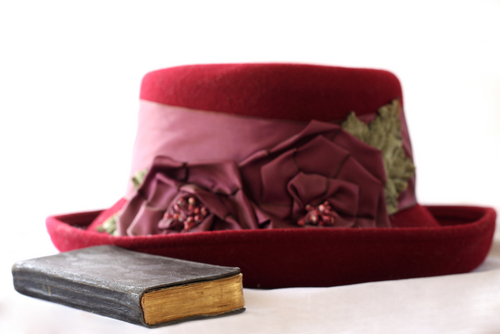 Yesterday morning at our beautiful Easter service, I looked across the aisle of our completely packed church and saw one of the young women at church wearing a fantastic hat. And I think Becky may have been the only woman wearing a hat. Immediately I felt a pang of regret that I hadn't remembered to put my outfit together with a hat.
So I nodded my head when I came across the Washington Post's front page story this weekend, headlined:
Yesterday morning at our beautiful Easter service, I looked across the aisle of our completely packed church and saw one of the young women at church wearing a fantastic hat. And I think Becky may have been the only woman wearing a hat. Immediately I felt a pang of regret that I hadn't remembered to put my outfit together with a hat.
So I nodded my head when I came across the Washington Post's front page story this weekend, headlined:
Church ladies and their big, bold hats: A fading tradition
Some might wonder whether such a light fashion story deserves front-page coverage. (In fact, some of the comments to the piece question the news decision considering all the wars and problems going on in the world right now.) Done right, I think it definitely could.
From the headline to the last word, church plays a role in this story. But it's a surprisingly one-dimensional role.
Elaine Saunders stepped into Bachrach’s Millinery in Northwest Washington one late winter day in 1953, and there it was, calling her name: a pale fuchsia straw hat with an upturned brim and matching rosebuds circling the crown.
“It’s a Mr. John,” Saunders, now 77, recalls without explanation, certain the designer’s name alone says this was no ordinary hat.
She paid $5 to put it on layaway and made regular installments until she’d covered the $35 cost. When she finally clutched the gold braided handle of the pink floral hatbox and strutted out of the shop, she knew that this final touch to her pale pink Easter suit would place her among the best-dressed young ladies at Zion Baptist Church. And that would be no small feat, since proper church ladies back then all wore hats — their finest, of course, on Easter.
For generations, church sanctuaries across the nation on Sunday mornings, especially in black churches and especially on Easter, transformed into a collage of hats: straw ones, felt ones, velvet ones, every shape, size and color, with bows, jewels and feathers, reaching for the heavens.
But anyone walking into today’s services expecting to see a nonstop parade of women making fashion statements on their heads will be sorely disappointed. Many daughters and granddaughters of the women who made bold and flashy hats synonymous with the black church have not carried on the tradition.
We learn all sorts of things about the millinery business and the way that some mothers weren't able to pass the tradition onto their children. I find all of this fascinating. My own mother has a freakishly large head (kidding, mom!) so she could never find hats to fit. But she loved seeing me in hats and would buy them for me frequently. I wore them throughout childhood and into my 20s. I'm not entirely sure why I don't wear them as much any more.
The story is full of people talking about wearing hats at church and how the practice is fading. "Regular church ladies, black and white," we're told, made up about half of one hat shop's business (the rest was for celebrities).
The decline, though, is only chalked up to a change in style. This is undoubtedly true but I wonder if, for a front-page story where one has the time to treat the topic seriously, we should get a bit more analysis.
For our purposes, I wonder if we're seeing a religion ghost. Is there something about a change in worship or a change in doctrine that affects this changed practice?
I have been in some churches -- black and white -- where head coverings are a pious option for the women. I have been in some churches -- black and white -- where worship has become significantly less formal and much more trendy over the years. Does that play a role? Are there denominational differences in the church hat culture? Am I wrong to think of this as more of a Protestant issue than a Catholic one?
The story is fine but I would have loved to hear some other voices. Maybe from pastors about what the change in hat styles signifies to them. Certainly there are others out there who have thought about the significance -- theological and otherwise -- of this change in how women dress for worship. For an article focused on church dress, it might not have hurt to have a bit more depth.
Image of a church hat from Shutterstock.
